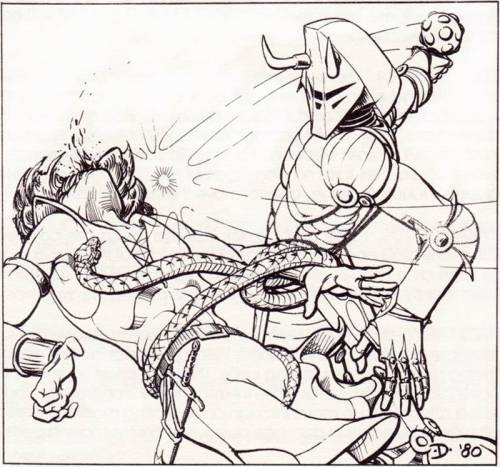Wednesday, April 16, 2025
Wednesday Comics: DC, July 1984 (week 2)
Friday, April 11, 2025
Weird Revisited: Robot Dungeon
I've written previously about a world where the dungeoneering was an done by androids who were the remnant of human civilization (all that's here). Well, there's another way to get dungeons crawling with robots, and that's by having a future, post-apocalyptic world that's been overrun by them. Instead of apes, or fairies, or vampires, let the robots take over something like Screamers (and the Philip K. Dick story it's based on "The Second Variety"), Terminator, or Magnus: Robot-Fighter. Unlike those examples though, human civilization can have been pushed back to pseudo-Medieval levels.
Say the robots have moved mostly underground, leaving humans to limp along on a damaged surface world. The underground bases of the robots would be a lot like dungeons. Robots would have made various robotic or bio-robotic guardians--monsters, of sorts. Maybe the robots are even aliens? A post-sentient, techno-organic swarm that landed and buried itself into the earth, spreading underground like roots, building robotic creatures in a myriad of forms as it went. You'd have a whole underground ecology of robots. Add "magic" (really psionic powers in disguise) and you've got a fantasy world, or close enough.
For a real fantasy world, assume that the alien robotic swarm invaded a fairly D&Dish world (except with maybe less conflict to begin with).
Wednesday, April 9, 2025
Wednesday Comics: Vigilantes & Warlords
Last week, in my Wednesday Comics post, I accidentally left off one comic, the issue of Vigilante from April 5, 1984:
Vigilante #8: Wolfman brings his Electrocutioner vigilante over from Batman #331, presumably so he can continue to clarify Vigilante's previously murky stance on where he draws the line regarding killing. We are also treated to a renewed examples of criminals getting off on pesky technicalities like illegal searches as Adrian Chase's friends try to convince him to become a judge. There's the issue of a mysterious microchip that the Controller is after. There's a nice sequence in the beginning where Vigilante is pursued by a guy in a mini-copter that really showcases the talents of Andru/DeCarlo.
In other news perhaps of interest to longterm readers of this blog...
We finally have a solicitation for the Warlord Omnibus. It supposedly only has a price of $75.00, which seems low given the page count (1040 pages).
In any case, it's supposed to include 1st Issue Special #8, Warlord #1-50, and Amazing World of DC Comics #12. For a volume 2 (if there is one) that leaves the non-backup stories from Warlord #52-71 (#51 is a reprint), Warlord Annual #1, Warlord (1992 limited series) #1-6, and Warlord (2009) #1-16 for a total of around 1005 pages in that one, by my count.
Monday, April 7, 2025
Arduin Got It
I don't know much of anything about Dave Hargrave or his inspirations for Arduin but the art and content suggest Hargrave's inspirations (or at least his artists inspirations) were much closer to mine and my friends' early influences than the likes of Gygax, Arneson, or Barker.
Friday, April 4, 2025
[Greyhawk] The Wild Coast
In the waning days of the Great Kingdom, folk who were faced with debts they could not pay or disagreements with the legal authorities that might see them imprisoned or facing the hangman often found it convenient to flee narrow area of flatwood, sandhill, and wetland along the Northwest edge of Wooly Bay. There, they would be, if not welcomed, at least accepted into the independent community that had grown up among the several, squabbling towns. The region had an infamous reputation and was known as the Wild Coast.
Wednesday, April 2, 2025
Wednesday Comics: DC, July 1984 (week 1)
Friday, March 28, 2025
[Greyhawk] North Province
 |
| Art by Mihai Radu |
The Overking was traditionally appointed by vote of the magnates ruling the constituent territories of the Aedi. One of these was the region now called North Province which was held by House Naelax since the Great Kingdom's founding.



























